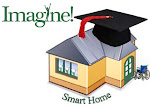 |
| Leah and Alex |
Today’s Technology Tuesday is going to be a little different than some of the others in that, rather than focusing on specific technologies, we’d like to share information about an individual working for Imagine! who is truly blazing the trail when it comes to incorporating technology into our services to improve the self-reliance of the individuals we serve.
More than seventeen years ago, Alex Andrews brought his curiosity and creativity to Imagine! to support people with intellectual and developmental disabilities to achieve their full potential. Long before technology was viewed as a viable support in our field, Alex was using his knowledge to wire devices to teach basic principles of cause and effect, so that individuals with significant disabilities could control and manipulate lights and sound by simply tapping on his or her chest, or by brushing his or her fingers up and down the front of his or her body, taking that critical first step toward independent decision making. Since then, Alex has pursued grant opportunities to improve and increase the access to technology so that individuals can learn, live, play, and work in their communities.
Today, as a Direct Support Provider (DSP) and technology architect, Alex is working locally and nationwide to create assessments and screening tools to assist people experiencing a disabling condition to identify technological solutions to increase independence, health, and safety throughout the community, at home, and at work. Alex’s latest venture has brought his knowledge into his home, where he and his wife support Leah as host home providers. Through a combination of low and high tech solutions, Leah uses an iPad to complete activities of daily living, and to prepare her for what she loves, which is heading out to her job in the community.
Here’s what Leah’s dad, Doug, had to say about the progress she has made since Alex began providing services, and how technology has played a role in her successes:
Alex’s work with assistive technology is being applied to Leah’s living situation. Alex remodeled a portion of his house to provide for Leah and future client(s). He has wired the environment that Leah now lives in to support her specific needs (with ‘sound prompting’ and communication systems). In only a few weeks, Leah is now waking up, starting her morning routine, contacting Alex and Diana when she completes her routine all without any personal contact. The same applies to her routine when she comes home from her ‘day program’ and for her evening routine. She is also learning to pack her bag with appropriate clothes and items she needs to visit us on weekends. All of these are first time events!
Alex has devised a method that allows prompting and supervision to be applied less and less as Leah progresses toward the goal of handling tasks without any prompting or support. She has already made measurable improvement toward performing daily routines independently. In addition, at her recent IP, Leah’s attending support group watched a video of Leah working with a prompting system to make oatmeal for herself in a microwave oven with no help. These professionals, (not to mention Leah’s parents), were overwhelmed to see Leah demonstrating such independent skills. It was clear to all that Leah was so proud of what she had accomplished.
Although Leah has a wonderful support group, it is without question that Leah’s growth, independence, and joy has advanced due only to Alex’s exceptional vision and caring. His drive to never stop looking for solutions and his knowledge of how to approach these challenges using any and all simple manual solutions or technological solutions is known to many. I personally have seen the effect that his effort has had on my daughter and it has been significant and has been witnessed by everyone that works with Leah.
Leah is showing an ability to provide for herself in many ways that would not be possible without Alex’s influence. I no longer allow thoughts of what Leah can’t do thanks to Alex. Also, my wife and I have both learned a great deal from Alex about how to be consistent in our support for her. He is always willing to share his knowledge without hesitation. He has greatly improved my life and the life of my daughter.
Imagine!’s well-deserved reputation as a leader in incorporating technology in services to individuals with intellectual and developmental disabilities is largely due to creative and dedicated employees like Alex. Thanks, Alex, for your efforts!




















